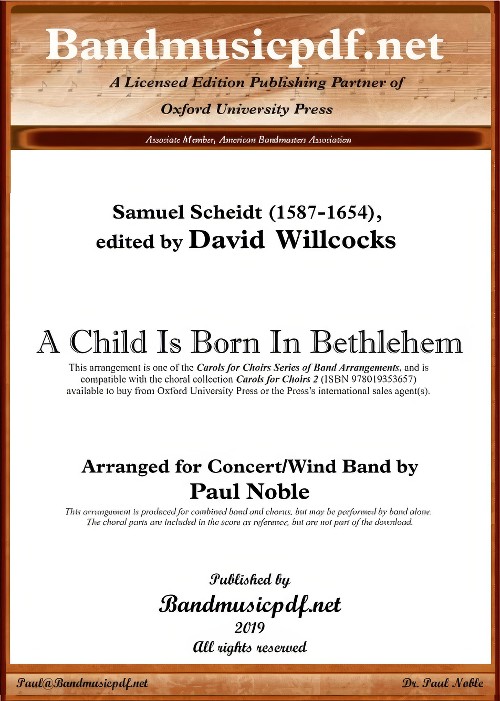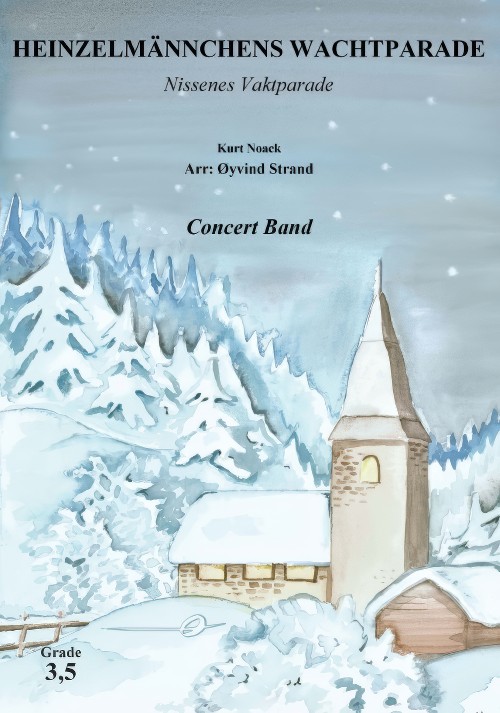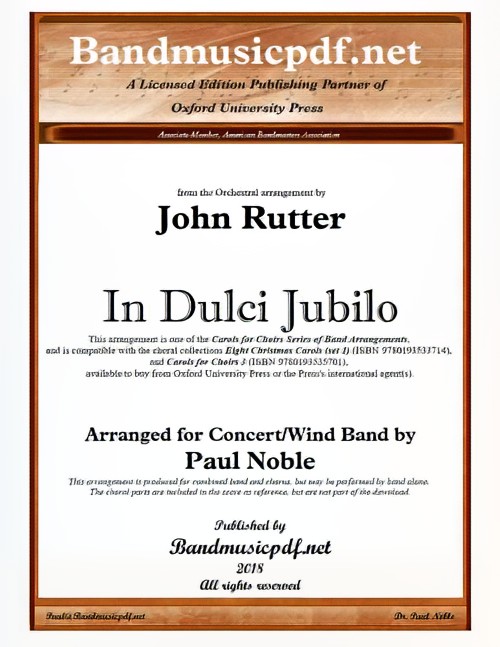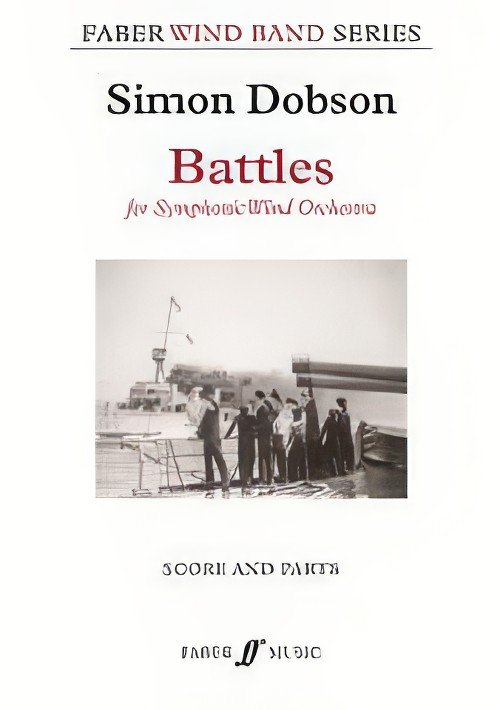Results
-
 £108.40
£108.40 -
 £69.99
£69.99 -
£76.99
German Love Song - Jacob de Haan
Dreaming of love. This is the theme of the folksong on which the composition was based. Its characteristic melody inspired Jacob de Haan to this instrumental romance with a transparent structure consisting of an introduction, the folk-melody, a development of the theme, the folk-melody accompanied by ornamental triplets followed by the final bars.
Estimated dispatch 7-14 working days
-
 £60.99
£60.99The Brandenburg Gate (German March) - Johnnie Vinson
Heralded by a fanfare-like figure for trumpets in the first strain, here is an appealing German-style march solidly scored for young players. Low brass take the lead on the second strain, followed by a contrasting lyrical sectionfeaturing the woodwinds. The full ensemble brings us to a rousing finish in this terrific-sounding march. (This is a nice follow-up to Johnnie's earlier international marches St. Petersburg March, New Forest March and The Crown ofCastile.) Dur: 2:30
Estimated dispatch 7-14 working days
-
 £59.80
£59.80Alte Kameraden - Carl Teike
It is the greatest tragedy in the life of a young composer if he happens to write his most successful piece at the beginning of his musical career. This holds true for Carl Teike, as the unsurpassed success at the beginning of his musical life was his march "Old Comrades". It is a sparkling piece that may well be labeled to be the German "march of marches". Carl Teike was born on Feb. 05, 1864 in Altdamm. After his parents had moved to Stettin, he had early contacts with military music as a youngster. The enthusiasm for this kind of music never left him throughout his life. He began a musical apprenticeship with City Music Director Bttcher in Wollin and already played in the spa orchestra of Bad Misdroy, which Bttcher conducted. Upon completing his apprenticeship, he enlisted as a volunteer in the band of the (5th Wrttemberg) King Karl Grenadiers No. 123 in Ulm. The musical and military environment there proved to be ideal for the ambitious young musician, who hoped to eventually study band music at the University of Music in Berlin. Above all, his military superior, bandmaster Julius Schreck supported young Teike wherever he could. Unfortunately the time in Ulm took a very unhappy turn, as Schreck's successor was extremely resentful towards Teike, and musical support was replaced by sheer harassment. On account of this, Teike retired from the military towards the end of 1889. Short employments in Ravensburg and Ulm evidently did not suit Teike, who was of northern German descent. This is why he applied for the Royal Police Force in Potsdam. Teike was accepted and entered service in 1895. The royal capital of the Hohenzollerns obviously stirred Teike to write a number of brilliant marches. He even became known abroad as the "musical policeman". Unfortunately he contracted a severe pneumonia while on duty, which eventually forced him to retire from the Royal Police Force in Potsdam. On February 01, 1909 he and his family moved to the prosperous provincial city of Landsberg on the Warthe (which is located east of Berlin in present-day Poland). There, Count Clairon d'Haussonville proved to be an understanding superior who paved the way for modest Carl Teike to continue composing, as his creativity had not suffered from this move. The disease which he had caught in Potsdam evidently was more severe than he was inclined to accept. In spring 1922, his state of health became worse, and in May of that year he passed away. Much too early - as many people felt. Teike's marches constitute an enrichment of the German concert march, as he never composed any street marches. Clear structures, musical ingenuity and a multitude of tone colors distinguish his works and shape them into something really new. It is this type of the march in particular that became the bedrock of the universal appeal of the German march. Even today Teike's marches stand unrivaled for musical quality and content - and they never are aggressive. Toward the end of his tour of duty in Ulm, Teike handed a new march to his superior, which, at the time, did not have a title yet. He in turn told Teike to "put it in a stove and burn it". As we know today, this was a classic misappraisal, as Teike subsequently named his march "Old Comrades" in view of his impending retirement. We do not even need to discuss the acceptance the march has met and still meets all over the world, as "Old Comrades" simply always has been a march of universal appeal. In his new arrangement, Siegfried Rundel did not change the essence of Teike's music, he rather sensitively adapted it to modern musical practice and to the instrumentation of the symphonic band on the basis of his deep respect for the works of Carl Teike.
Estimated dispatch 7-14 working days
-
 £75.00
£75.00A Child is Born in Bethlehem (Concert Band with Optional Choir - Score and Parts) - Scheidt, Samuel - Noble & Willcocks
Samuel Scheidt (1587 - 1654) was a German composer, organist and teacher of the early Baroque era, and was one of Germany's most distinguished composers at that time, especially in the field of keyboard music. His three volumes of Tabulatura nova (1624) are a monumental compendium of song and dance arrangements, sets of variations, fantasias, toccatas, fugues and liturgical pieces (often plainsong-based) for the Lutheran Mass and Office. Likewise his four books of Geistliche Konzerte illustrate the ways of elaborating a chorale, fusing declamatory ideas with contrapuntal writing. Scheidt was the first internationally significant German composer for the organ, and represents the flowering of the new north German style, which occurred largely as a result of the Protestant Reformation. Scheidt's music is in two principal categories: instrumental music, including a large amount of keyboard music, mostly for organ; and sacred vocal music, some of which is a cappella and some of which uses a basso continuo or other instrumental accompaniment. Edited for double chorus by David Willcocks, this arrangement represents one in the Series of Band Arrangements compatible with David Willcocks' Carols for Choirs.
Estimated dispatch 7-14 working days
-
£82.00
Living it up (CB) - Bert Kaempfert - Frank Boonen
Bert Kaempfert was a German composer, arranger and big band leader. Together with Max Greger and James Last, he was one of the most successful post-World War II German orchestra leaders in mostly American nightclubs. His international breakthrough was in 1960, his absolute top with the song 'Strangers in the Night'.
Estimated dispatch 7-14 working days
-
 £94.00
£94.00Heinzelmannchens Wachtparade (Concert Band - Score and Parts) - Noack, Kurt - Strand, Oyvind
The story of the Heinzellmannchen (Gnomes) is connected to the German city of Cologne. The gnomes were small creatures living underground but appeared during the night, when the people were asleep, doing all the work that had to be done in the city, so that the citizens of Cologne could be lazy, relaxing the whole day. At last, there was a tailor's wife getting so curious about the gnomes that she scattered dried peas onto the floor so that the gnomes slipped and fell, making a lot of noise. The gnomes got infuriated and disappeared forever and the citizens of Cologne must thereafter do all the work themselves.Kurt Noack (1893-1945) was a German composer, arranger and orchestra leader, working mainly with light music and marches. The characteristic piece Heinzellmannchens Wachtparade (Gnome's parade) from 1912 is his most famous composition, originally written for piano.This arrangement is made a little parodic, filled with joyful interjections, trying to give these little gnomes a bit of character, with pictures from Disney's Santa's workshop in mind.Duration: 7.00
Estimated dispatch 7-14 working days
-
 £75.00
£75.00In Dulci Jubilo (Concert Band with Optional Choir - Score and Parts) - Noble & Rutter
One night in 1328, the German mystic and Dominican monk Henrich Suso (or Seuse) had a vision in which he joined angels dancing as the angels sang to him Nun singet und seid froh or In Dulci Jubilo. In Suso's biography (or perhaps autobiography), it was written: Now this same angel came up to the Servant [Suso] brightly, and said that God had sent him down to him, to bring him heavenly joys amid his sufferings; adding that he must cast off all his sorrows from his mind and bear them company, and that he must also dance with them in heavenly fashion. Then they drew the Servant by the hand into the dance, and the youth began a joyous song about the infant Jesus, which runs thus: 'In dulci jubilo', etc. In Dulci Jubilo is among the oldest and most famous of the macaronic songs, one which combines Latin and a vernacular language such as English or German. Five hundred years later, this carol became the inspiration for the 1853 English paraphrase by John Mason Neale, Good Christian Men, Rejoice. Perhaps the earliest English version appeared c.1540. That popularity has endured for nearly 700 years. It's the rare contemporary collection of Christmas carols that doesn't contain a carol based on this ancient jewel.
Estimated dispatch 7-14 working days
-
 £100.00
£100.00Battles (Concert Band - Score and Parts) - Dobson, Simon
Battles was written for the restoration of the epic 1927 silent film The Battles of Coronel and Falkland Islands, and was commissioned by the British Film Institute (BFI) in 2013. The work presents eight contrasting scenes as a continuous sequence: War, Introduction of Admiral von Spee, German Banquet, Building Steam/Preparing, Islanders, Call to Arms, Great Battle at Sea and Victory. The original score was written for a small chamber orchestra, symphonic brass and a substantial batterie of tuned and untuned percussion. Battles has been edited for symphonic wind orchestra with percussion and harp. Composer Simon Dobson says of his colourful score, "I wanted to keep things simple and clear, so there is a British theme, a fanfare march idea, often heard on trumpet, and a German naval theme, which is a more angular motif." Duration: 13.00
Estimated dispatch 7-14 working days
